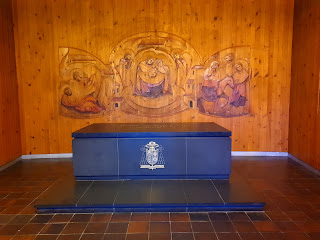While in Liverpool today, there was also time to walk along Hope Street from the Anglican Cathedral to the Metropolitan Cathedral of Christ the King.
Hope Street, which connects Liverpool’s two Cathedrals, has the Better Together - Sheppard Worlock memorial which celebrates the lives and achievements of Archbishop Derek Worlock and Bishop David Sheppard. The bronze sculpture takes the form of two 4.5m high doors. It’s strong visual presence frames the views of the Cathedrals and allows the viewer to walk between the ‘open doors’. Low relief press cuttings and other symbols from Bishop David and Archbishop Derek’s lives allow the audience to engage with the piece further.
Architects throughout the world were invited in 1960 to design a Cathedral for Liverpool which would relate to the existing Crypt, be capable of construction within five years, cost at the current prices no more than £1,000,000 for its shell, and most important of all, express the new spirit of the liturgy then being radically reformulated by the Second Vatican Council. Of 300 entries from all over the world, Sir Frederick Gibberd’s (1908-1984) design was chosen, and building began in October 1962. A Pathé newsreel showed stages of the building process. Less than five years later, on the Feast of Pentecost, 14 May 1967, the completed Cathedral was consecrated.
Gibberd’s design was highly innovative and the circular plan form put the altar at the centre of everything, with sixteen structural ribs carrying the huge circular lantern of some two thousand tons which lights the body of the cathedral. Around the perimeter, chapels of various designs stand in the interstices of the ribs, separated by glazed strips to emphasise their independence from the main space.
Externally the building formed a crown rising above the city streets and providing a counterpoint to the large central tower of Giles Gilbert Scott’s Anglican cathedral, with the contrast further emphasised by the use of Portland stone to contrast with Scott’s red sandstone. Internally a large baldacchino is suspended over the altar, its design reflecting the structure of the cathedral and the ‘crown of thorns’ of the lantern above.
The Cathedral's majestic interior includes modern works of art and stunning design features, such as its striking Lantern Tower - the world’s largest area of coloured glass. The stained glass to the main lantern was designed by John Piper and Patrick Reyntiens and depicts in abstract the Trinity using the three primary colours. Various artworks were commissioned from leading artists and sculptors including Elisabeth Frink, Ceri Richards, Margaret Trehearne and Sean Rice. The gates of the freestanding baptistery adjoining the building, and the floor pattern were by David Atkins, an artist who was a member of the Gibberd practice.
Of special note is the magnificent Lutyens Crypt and Treasury, situated within the Cathedral. An architectural gem in its own right, the Crypt is one of the most significant works in this country of the leading British architect Sir Edwin Lutyens. Part of an earlier Cathedral design, the Crypt offers a fascinating glimpse of what might have been, had it been completed.
The Cathedral is currently hosting the sculpture ‘The Need for Freedom’ by prominent contemporary Ukrainian artist, Dmytro Iv. This striking artwork, which shows the figure of a chained but rising woman, represents Ukraine’s struggle for peace and freedom. Created in 2012 and measuring 7 foot in height, it consists of dozens of steel chains welded together in over four thousand points. The artwork was previously exhibited in the UK in 2015, when it won a silver award at the prestigious international contemporary art festival ‘Passion for Freedom’.
-------------------------------------------------------------------------------------------------------
Echo and the Bunnymen - What Are You Going To Do With Your Life?




























































No comments:
Post a Comment